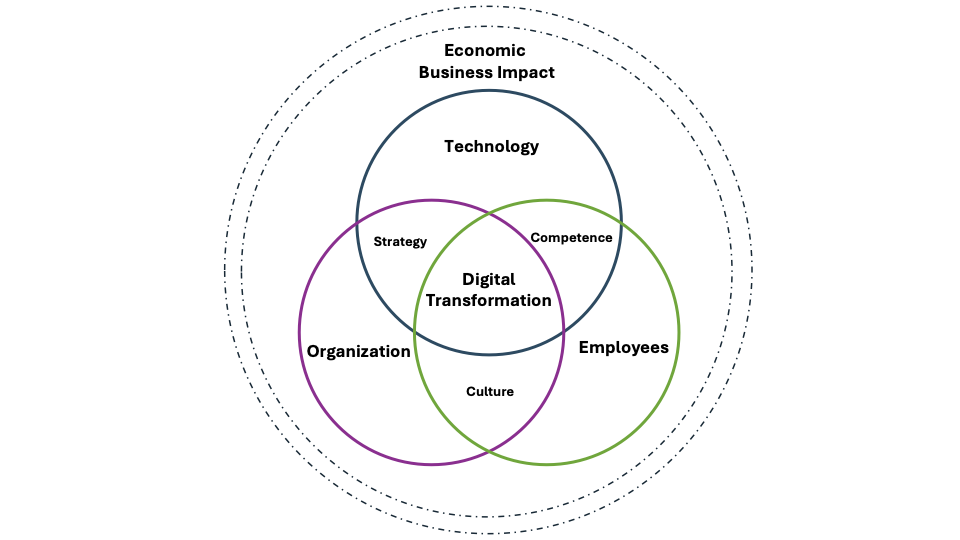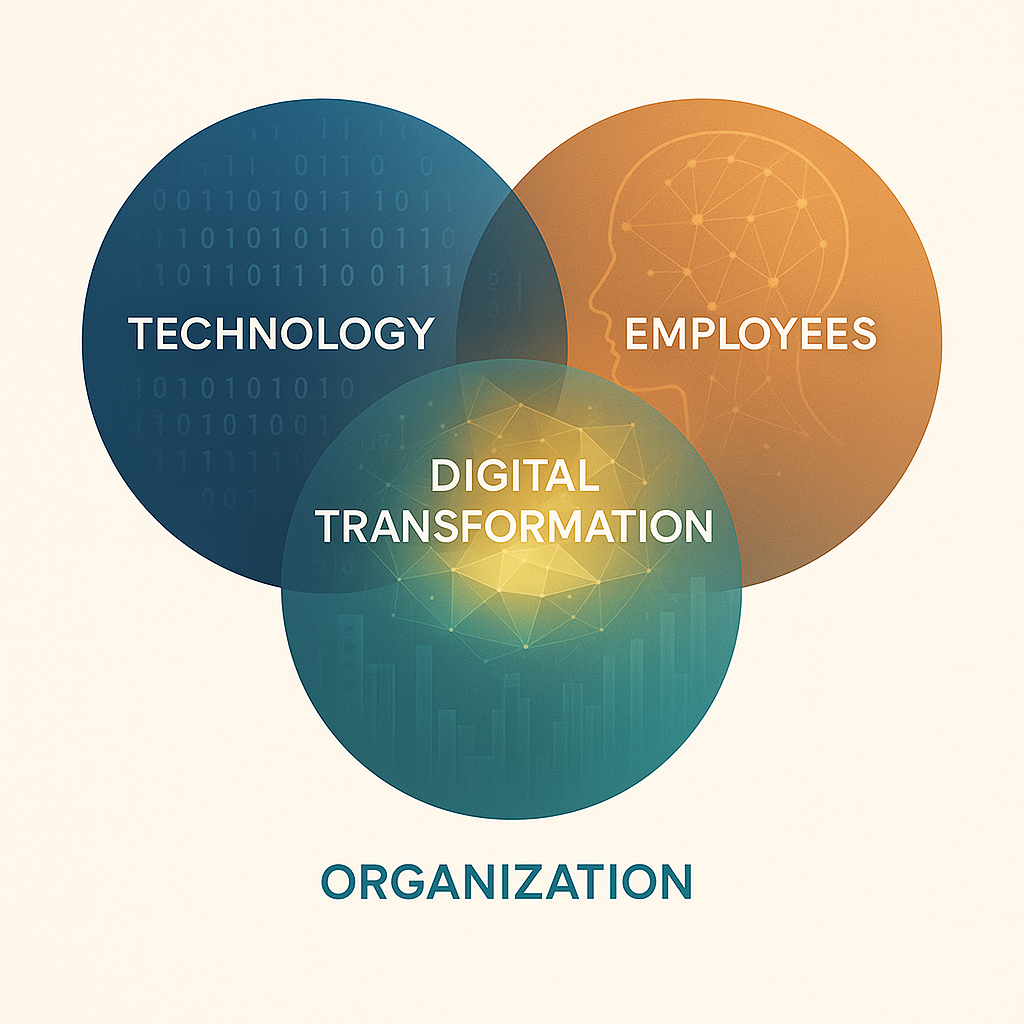Digital transformation is the driving force behind sustainable business success in today’s fast-changing world. As I observe organizations striving to stay competitive and relevant, I consistently see three critical realms shaping the path forward: Technology, Employees, and Organization. Each acts as a pillar supporting the ultimate goal—delivering measurable economic and business impact.

The Venn diagram above—an adjusted version of Hebing and Stolpe (2020)—serves as a foundational roadmap. It visually demonstrates how these three realms intersect, with Digital Transformation at the center. This framework guides the direction of this blog and all future content, ensuring a holistic approach to the topic.
The Three Pillars of Digital Transformation
Technology
Technological advancements—especially in machine learning, artificial intelligence (AI), and data engineering—are revolutionizing industries at an unprecedented pace. From automating routine tasks to enabling data-driven decision-making, technology provides the tools that can fundamentally reshape business models and customer experiences. However, I have found that technology alone is not a silver bullet. Its true value is only realized when these innovations are thoughtfully integrated and strategically aligned with broader business objectives. For example, implementing AI-powered analytics can unlock new insights, but without a clear business purpose, these insights may never translate into action or value.
Employees
People are at the heart of every transformation journey. No matter how advanced the technology, it is employees who drive adoption, champion innovation, and ultimately determine the success or failure of any digital initiative. I believe that topics such as continuous learning, AI literacy, employee voice, engagement with works councils, and voluntary participation are essential. Empowering employees with the right skills and fostering a culture of openness and curiosity ensures that technological investments deliver real value. For instance, providing targeted training on new digital tools or involving employees in decision-making processes can significantly boost engagement and accelerate transformation.
Organization
Organizational change is about more than just restructuring teams or updating processes—it’s about cultivating the right culture and mindset. Leadership, governance, and organizational style all play decisive roles in how technology and people come together to achieve business goals. From my perspective, a forward-thinking organization encourages experimentation, supports cross-functional collaboration, and embraces change as a constant. Effective governance structures ensure that digital initiatives are prioritized and resourced appropriately, while strong leadership sets the tone for a culture that values innovation and resilience.
Where These Realms Intersect
At the intersection of Technology, Employees, and Organization lies Digital Transformation—a dynamic space where Strategy, Competence, and, most importantly, Culture converge.
-
Strategy ensures that technological investments are purposeful and aligned with business goals, providing a clear roadmap for transformation. In my experience, an effective strategy also includes a robust data strategy and strong governance structures. This means establishing clear policies for data collection, management, and usage, as well as ensuring data quality, security, and compliance. By prioritizing data strategy and governance, I can help organizations make informed decisions, maximize the value of their data assets, and maintain trust with stakeholders—all of which are essential for successful digital transformation.
-
Competence reflects the skills, knowledge, and capabilities employees need to succeed in a digital environment. This includes fostering AI literacy across all levels of the organization, as well as offering further training and continuous learning opportunities. In my experience, investing in upskilling and reskilling employees—whether through workshops, online courses, or hands-on projects—empowers them to adapt to new technologies and confidently navigate digital change. Ongoing development and adaptability are essential for building a workforce that can fully leverage digital tools and innovations.
-
Culture shapes how change is embraced, how people collaborate, and how innovation thrives within the organization. A strong, positive culture encourages curiosity, openness to learning, and proactive engagement with new technologies like AI. In my experience, organizations that prioritize a learning mindset—where further training and AI literacy are valued—are better equipped to overcome resistance, foster collaboration, and drive successful digital transformation. Ultimately, culture can be the deciding factor between transformation success and failure.
Surrounding all these is the ultimate objective: Economic and Business Impact. Every post on this blog will connect these elements to tangible value for organizations—whether it’s increased efficiency, improved customer satisfaction, or new revenue streams.
What to Expect
This post sets the foundation for the exploration of digital transformation. Future posts will deep dive into these aspects—whether it’s explaining core concepts in machine learning, artificial intelligence, or data engineering, or exploring best practices in employee development and organizational change. Each topic will always be approached with a clear focus on practical impact and measurable business value. The goal is to provide insights that support translating digital transformation into real-world results for organizations.
To help you easily navigate and connect with the topics that matter most to you, each future post will include hashtags such as #Technology, #Employees, or #Organization, indicating its primary focus area.
Join the Conversation
Digital transformation is a journey, not a destination. Whether you are a technology leader, HR professional, or organizational strategist, I aim to provide actionable guidance and spark meaningful discussion. Your feedback and experiences are always welcome—let’s shape the future of business together.
Sources
Hebing, Stolpe (2020): Der Faktor Mensch – Technologien alleine machen keine digitale Transformation

Comments